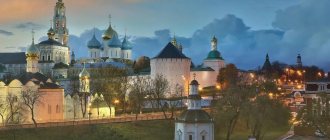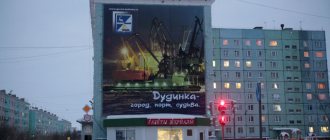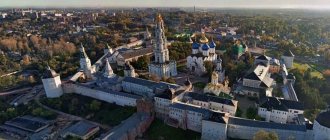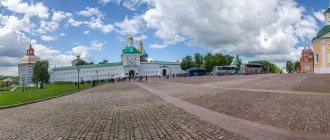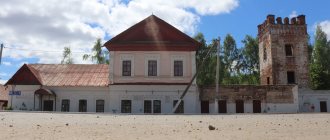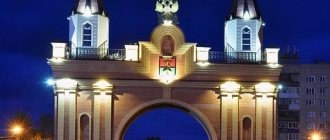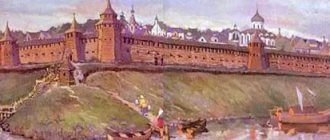I wandered around the site and decided to write about my hometown - Pavlovsky Posad. The townspeople affectionately call him Pavlik. You can find a lot of information on the Internet about the fact that our city is very old, with a rich history. There you will also see colorful photographs of our attractions. I, as a person who has lived in Pavlovsky Posad all my life, want to tell about it to those who are just planning to move to us. Moreover, I will write everything as it is, without embellishment.
I love my city, which is probably why I didn’t go to live in Moscow. Small towns have a different rhythm of life, noticeably different from the capital. I say this so confidently because I go to work in Moscow every day. It takes more than two hours to travel one way. It doesn’t seem very far from Pavlovsky Posad to Moscow – 68 kilometers. But if you go by car, the journey can take more than three hours.
Traffic jams on the roads to Moscow are our problem. In the morning and evening, as well as on weekends, all highways (Gorkovskoye, Egoryevskoye, Nosovikhinskoye highways) are closed. Therefore, in order not to be late for work, you have to take the train. This pleasure is dubious. It is not always possible to find a place and sometimes you have to stand on your feet for almost an hour and a half. There are express trains to Moscow (they are more expensive), they go faster and there are always seats, but I leave earlier, otherwise I won’t be able to get to work in time. The trains can be very stuffy, especially in the summer. I write in detail about all this for a reason. If you decide to come to us for permanent residence, then first think about where you will work.
Work and salaries
In Soviet times, there were many textile industry enterprises in Pavlovsky Posad. Everyone knows the woolen Pavlov Posad shawls that made our city famous throughout the world. Now things are different. Many textile factories have closed, and in their place are now shopping centers on Lenskaya. I have nothing against the shopping center itself. The stores are excellent, the selection is good, the prices are good. Yes, but there used to be a factory on this site, where my grandmother also worked. The factories were closed, and no one thought about where people would work now. So we have to go to work in Moscow. You arrive home in the evening at half past eight. There is almost no time left for home and family. But in Moscow at least the salaries are a little higher. Where to work in our city?
Stores are constantly looking for salespeople. But the salary is 15-18 thousand, how can you live on that kind of money? You can get a job as a hairdresser. Almost all men who have their own cars work in taxis. Including my husband. But a trip around the city costs 120-150 rubles. There are a lot of cars, not very many clients. So calculate how much you can earn per day, because you also have to pay the company where the taxi driver works. It’s good if you come across a client who will take a taxi to Moscow. This is a profitable order.
Of the old industrial enterprises in the city, there are Exiton, a worsted mill, “Bereg” in Bolshie Dvory, an aluminum mill, a spinning, silk and clothing factory. There is also a PATP (motor transport enterprise). Packers and movers are constantly needed among the new ones at Sibirsky Bereg. But the salaries there are also meager. Now, if you are a carpenter or roofer, you will definitely find a job. In the outskirts of the city there are many dachas where new houses are being built. Yes, they are also being built in villages. The city has many construction markets and stores with building materials.
But if you do not take into account the difficulties with work, then it is quite possible to live in Pavlovsky Posad. We have both modern multi-storey buildings and private houses. There is a lot of greenery, in the spring the city is all in bloom. We have a lot of stores. There are large chain supermarkets “Magnit”, “Atak”, “Pyaterochka”, “Dixie”, “FixPrice”. There are many beauty salons in the city, so there are no queues.
PAVLOVSKY POSAD
PAVLOVSKY POSAD, a city in Russia, in the eastern part of the Moscow region, the center of the urban district of the same name. Population 63.6 thousand people. (2019). Located on the river. Klyazma, at the confluence of the river. Vokhonka (Vohna). Railroad station. The Volga federal highway (Moscow – Vladimir – Nizhny Novgorod – Kazan – Ufa) runs 6 km north of P.P.
Story
It arose on the territory of the Vokhna volost, which was first mentioned in 1336 in the first spiritual charter of the Grand Duke of Vladimir Ivan I Danilovich Kalita. In the 1570s – 1764 patrimony of the Trinity-Sergius Monastery. In 1585/86, in the scribe book of the Moscow district as part of the Vokhna volost, the Dmitrievsky churchyard and the village of Pavlovo were first mentioned, which by the mid-1640s. merged into Pavlovo (Vohna), which became the center of the surrounding lands. Since 1764 it has been a state village. From the 18th century Peasant weaving enterprises opened in Pavlov, local peasants Labzins, Shirokovs, Shchepetelnikovs and others became large entrepreneurs. From the end of the 18th century. center for the production of Pavlovsk scarves. During the Patriotic War of 1812, partisans and fighting squads were active in the village and its environs. In 1839–45, the Moscow–Nizhny Novgorod highway, which ran near Pavlov, was built. By decree of Emperor Nicholas I dated June 2(14), 1844, the unification of the village. Pavlovsky settlement was formed in Pavlovo (Vokhna) and the villages of Dubrovo, Zakharovo, Melenki and Usovo. It received simplified city government, but until 1917 it had the official status of a settlement. In 1861, traffic was opened along the Moscow-Vladimir railway line that ran directly next to the settlement. By the beginning of the 20th century. Pavlovsky Posad is one of the important centers of textile production in the Moscow region, among the largest enterprises are the factories of the Russian-French Anonymous Society of Cotton Manufactory, the factories of the Partnership of Y. Labzin and V. Gryaznov (now the Pavlov Posad Shawl Manufactory), etc. The city since 1917 (without official registration; legislative status was enshrined in 1925). On October 26 (November 8), 1917, Soviet power was established. During the Great Patriotic War, the textile enterprises of Pavlovsk Posad were converted to produce products for the front: uniforms, raincoats, parachute fabric, etc. District center (1929–59, 1965–2017) of the Moscow region. In 1959–65, it was part of the Noginsk district of the Moscow region. In 1990–2010 it had the status of a historical city of Russia. City of regional subordination (1939–2001, since 2017). From 2021 the center of the city district of the same name.
Architecture
Pavlovsky Posad. Church of the Intercession of the Blessed Virgin Mary of the Intercession-Vasilievsky Monastery. 1870–72. Refectory and bell tower – 1907–10. Photo by Yu. A. Demidova.
In the central part of Pavlovsky Posad (on the right bank of the Klyazma), a regular layout has been preserved (it began to take shape around 1840, the plan was approved in 1887) and partially the buildings of the mid-19th - early 20th centuries. On the right bank of the Vokhonka, on Voskresenskaya (formerly Bazarnaya) Square, the classicist house of the merchant D.I. Shirokov (late 1830s; now the Exhibition Hall) has been preserved; near the square - the Ryazankin estate (1830–40s), a church in honor of the Kazan Icon of the Mother of God (1900s, the top was restored in 2007). Also preserved are: the building of the factory of T-va Ya. Labzin and V. Gryaznov, a number of private houses of the late 19th - early 20th centuries; the building of the Vulcan cinema in the spirit of neoclassicism (early 20th century); wooden houses with carvings from the 19th – 1st half of the 20th centuries. (including the house in which actor V.V. Tikhonov was born). In the southern part of the city there is a quarter of factories of the Russian-French anonymous joint-stock company (late 19th - early 20th centuries).
In Zarechye (on the left bank of the Vokhonka), in the former Dmitrievsky churchyard, there is one of the main architectural dominants, the empire-style 4-tier bell tower (1838–41) of the Resurrection Church (1703, destroyed in the 1940s). Next to it is the Church of St. Nicholas (1914). In Zarechye there is also a chapel in memory of the deliverance from the French invasion in 1812 (1912, architect V.K. Serotsinsky; destroyed in 1932, restored in 2007–08). On the northern outskirts of the city is the Intercession-Vasilevsky Monastery (since 1903; closed in 1920, revived in 1995) with the churches of the Intercession of the Blessed Virgin Mary (1870–72; the lower church of St. Basil the Confessor was consecrated in 1874; the refectory and bell tower in the Russian style - 1907 –10, architect V. P. Desyatov) and St. John the Baptist (2000s). In the former village The town, on the left bank of the Klyazma, is a 4-pillar Ascension Church in the neo-Byzantine style (1908, architect Desyatov). Old Believer Church of the Nativity of the Virgin Mary in the former village. Kornevo (1997).
15 km southeast of Pavlovsky Posad, in the village. Novozagarye, - Assumption Church in the Peter the Great Baroque style (1714–15, rebuilt in the Empire style in 1844, architect A. G. Grigoriev; refectory and bell tower in the Russian style, 1906–11, architect V. P. Desyatov).
Centers of science and culture
Branches of universities: Russian State Social University, Modern Academy of Humanities, Russian State Humanitarian University, Russian International Academy of Tourism. History and Art Museum (1971; in a wooden building from the early 20th century; collection of scarves).
Farm
Light industry is traditionally important: the Pavlovo Posad Shawl Manufactory (1795) produces over 400 types of shawls, shawls, scarves, mufflers, stoles, tablecloths made of wool, cotton, and silk; “Pavlovo Posad Worsted Man” (1864) – over 100 items of wool blend fabrics; “Pavlovo Posad silk” (1812) – decorative fabrics for various purposes (including curtains, church fabrics, lining, furniture). Production of electronic products (Exciton), cast-insulated conductors (RTK-Electro-M), fire extinguishers and fire hoses (Bereg; 1929), paints and varnishes (BASF Vostok), liquid detergents (Ton "; 1997), cardboard containers (Pavlovo-Posad Corrugated Corrugated Plant), paper hygiene products (Papyrus), kitchen furniture (Diamant-Pro), aluminum profiles (International Aluminum Company; 2002), ceramic bricks ( “Pavlovskaya Ceramics”, 1889), ceramic and porcelain dishes (“Ceramic Manufactory”), garments (“Thermoline”), sports equipment and inventory (“Dynamics Sports Equipment Plant”; 2019).
Medicine, communications and other “little things in life”
Medical care, probably like everywhere else now, is different. Free healthcare is not up to par, there are queues at clinics, and it’s difficult to get to specialists. But there are private clinics. Dental clinics "Prodent" and "Tweed" are not bad. The equipment is modern, but a little expensive. Recently, many pharmacies have opened.
You can live with your family in Pavlovsky Posad. Our schools are normal. There is a lyceum. My daughter goes to music school and to the swimming pool.
Our connection is good. There are many mobile operators: MTS, Megafon, Beeline, Skylink. A lot of megaphone towers have been installed in the area recently, so the Internet via modem works well. There is also GlobalTel. This is the satellite communications operator GlabalStar. By the way, the GlobalStar satellite connection station is located in our city, on Yuzhnaya. This is our local landmark, there are only three of these in the country!
Transport in the city works well. Buses run on schedule, there are many minibuses. Again, there are taxis. If you call through a company, a trip around the city will cost 120 rubles. There are a lot of cars, so you don’t have to wait more than ten minutes for a taxi.
Story
It was first mentioned in 1339 as the village of Pavlovo or Vokhna in the spiritual charter of Ivan Kalita. It was the patrimony of Prince Dmitry Donskoy.
During the Patriotic War of 1812, the Vokhonsky volost was one of the centers of the partisan movement against Napoleonic troops: in the area of present-day Pavlovsky Posad, a battle took place between units of General Ney’s division and local peasants under the leadership of the volost elder E. S. Stulov, the peasant G. M. Kurin and Sotsky I. Ya. Chushkin.
The city of Pavlovsky Posad was established by the decision of Emperor Nicholas I on June 2, 1844 on the site of the villages of Pavlovo (aka Vokhna), which gave the city its name, Zakharovo, Usovo, Dubrovo and Melenki. Subsequently, the villages of Gorodok, Kornevo, Prokunino, Filimonovo, Stepurino also became part of the city.
Culture
There are several museums in the city. The Pavlovo Posad Historical and Art Museum has been operating since November 1971 (until 2003 - the Pavlovo Posad City Museum of Local Lore). From 1999 to 2003, the Firefighting Museum operated. In 2003, it was closed, and the historical property was transferred to the management of the local history museum.
On Bolshaya Pokrovskaya Street, in the building of the Palace of Culture of the Pavlovo-Pokrovskaya Factory, the Museum of the History of Russian Scarves and Shawls has been operating since 2002.
In the center of the city there is an exhibition hall “Shirokov’s House”, where various exhibitions are constantly held.
The city is also home to the Pavlovo-Pokrovsky Palace of Culture and the Oktyabr Cultural Center.
On September 6, 2012, the Pavlovsky cinema opened in the Alyonushka business center with two halls with 80 seats each.
Attractions
- Bell tower of the Resurrection Cathedral.
- Pokrovsko-Vasilevsky Monastery.
- Church of the Nativity of the Virgin Mary.
- European Vipassana Center.
- Church of the Ascension of Christ on Gorodok.
- Church of St. Nicholas in Filimonov.
- House-museum of People's Artist of the USSR Vyacheslav Tikhonov.
Sculpture and monuments
- Monument to the hero of the Patriotic War of 1812 Gerasim Kurin.
- Bust of cosmonaut V.F. Bykovsky, a native of the city. Installed near the Alyonushka KBO building on June 14, 1983.
- Monument-bust to the founder of the Cheka F. E. Dzerzhinsky.
- Monument "In memory of those killed during the counter-revolutionary uprising in 1918."
- A sculptural composition of 5 figures (each figure symbolizes one locality and a specific industry), dedicated to the birth of Pavlovsky Posad. Installed in the northern part of Revolution Square.
- Tank T-64, on a pedestal. A plaque on the pedestal: “Dedicated to the feat of the defenders of the Fatherland.” Installed in 2004 opposite the military registration and enlistment office.
- Monument to V.I. Lenin.
